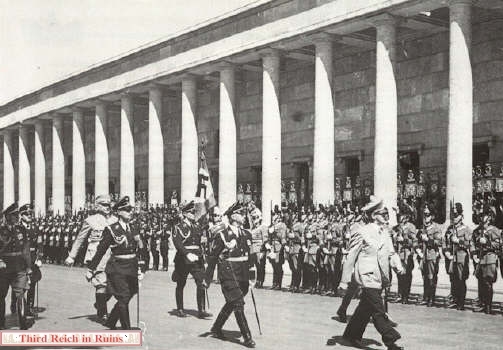|
Munich / München
Part 4 - Haus der Deutschen
Kunst - Museum of German Art
The Haus der
Deutschen Kunst (House of German Art) was built in 1933-37 to replace the Munich
Art Gallery (Glass Palace) which had burned in 1931. Designed by architect Paul Ludwig Troost
in the neo-classical Third Reich style, the building still serves Munich today
as an art museum (Haus der Kunst).
Click here to visit a subpage on the Nazi art
exhibits in the Haus der Deutschen
Kunst.

This artist's conception from 1933 shows
the planned Haus der Deutschen Kunst, or "Neuer Glaspalast," which was
to replace the
old "Glass Palace" art museum, burned in 1931. The large statues in
the front colonnade were never installed. (period postcard)
|

|

|
|
The Haus der Deutschen Kunst was
officially opened by Adolf Hitler on 18 July 1937, with the opening of
the first Greater German Art Exhibition. On the right, Hitler,
Heinrich Himmler, and others inspect ceremonial troops uniformed as
Bavarian infantry, during the grand opening ceremony. (National
Archives, RG 242-HB)
|
 |
 |
| Scenes
from the opening day ceremonies, 18 July 1937. The modern view below was
taken while the main hall was being readied for a new exhibit. (above
left - Life Collection; Bundesarchiv) |
 |
 |

In his speech for the opening of the
museum, Hitler dedicated the building to the art of the German people.
Munich Gauleiter Adolf Wagner looked on from the side. (period photo
album)
|

|

|
| The
cornerstone laying for the Haus der Deutschen Kunst was held on 15
October 1933, amid much pomp and ceremony. (left - period
postcard; right - "Der Staat der Arbeit und des Friedens,"
Altona-Behrenfeld, 1934) |
|

|

|
| On the
left are the chief artisans of the construction company with the
ceremonial silver hammer, before it was used. On the right is a
memorial plaque listing the names of the primary financial supporters
of the project, which was attached to the wall of the Haus der
Deutschen Kunst, and can now be seen inside the building. (left
- "Illustrated London News") |
|

|

|
| Left -
a parade of mounted swastika flag bearers pass the Haus der Deutschen
Kunst, probably during the 1937 opening ceremonies. Right - a
visitor's snapshot in 1940. |
|

|

|
| The swastika-motif mosaics
can still be seen today in the ceiling panels of the colonnades at
front and rear of the building. |
|

|

|
| The
U.S. Army takes over in May 1945. Notice the camouflage netting
hanging off the building in the view at left. The HDK building served
as a U.S. military Officers Club for the Munich garrison, for several
years following 1945. (U.S. National Archives, RG111SC) |
|

|

|
| The Haus der Deutschen Kunst
included a formal dining area and a more relaxed pub-style dining
area. ("Bauten der Bewegung," Vol. 1, 1938) |
 Continue
to Part 5, Other Third Reich Sites in Munich Continue
to Part 5, Other Third Reich Sites in Munich
 Back to the Third Reich in Ruins homepage
Back to the Third Reich in Ruins homepage
|
